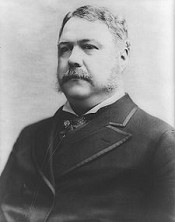Arthur Chester Alan

Chester Alan Arthur (October 5, 1829 – November 18, 1886) was an American politician who served as the 21st President of the United States. Arthur was a member of the Republican Party and worked as a lawyer before becoming the 20th Vice President under James Garfield. While Garfield was mortally wounded by Charles J. Guiteau on July 2, 1881, he did not die until September 19, at which time Arthur was sworn in as president, serving until March 4, 1885. Before entering elected politics, Arthur was a member of the Stalwart faction of the Republican Party and a political protégé of Roscoe Conkling, rising to Collector of the Port of New York, a position to which he was appointed by President Ulysses S. Grant. He was then removed by the succeeding president, Rutherford B. Hayes, in an effort to reform the patronage system in New York. To the chagrin of the Stalwarts, the onetime Collector of the Port of New York became, as President, a champion of civil service reform. He avoided old political cronies and eventually alienated his old mentor Conkling. Public pressure, heightened by the assassination of Garfield, forced an unwieldy Congress to heed the President. Arthur's primary achievement was the passage of the Pendleton Civil Service Reform Act. The passage of this legislation earned Arthur the moniker "The Father of Civil Service" and a favorable reputation among historians. Publisher Alexander K. McClure wrote, "No man ever entered the Presidency so profoundly and widely distrusted, and no one ever retired… more generally respected." Author Mark Twain, deeply cynical about politicians, conceded, "It would be hard indeed to better President Arthur's administration." Chester Alan Arthur was the son of Northern Irish-born preacher William Arthur (born in Cullybackey, Ballymena, Northern Ireland, United Kingdom) and Vermont-born Malvina Stone Arthur. Malvina's grandfather, Uriah Stone, fought for the Continental Army during the American Revolution and named his son, Malvina's father, George Washington Stone. Malvina's mother was part Native American.[1]:4 Arthur's father was a British-Irish citizen of Scottish descent, who naturalized as a U.S. citizen in 1843.[2] Arthur's restored ancestral home from the late 18th Century is in County Antrim in Northern Ireland. An interpretive center at the cottage tells the story of the Arthur family, and provides visitors with demonstrations of life in Ireland over the last 200 years.[3] Most official references list Arthur as having been born in Fairfield in Franklin County, Vermont on October 5, 1829. However, some time in the 1870s Arthur changed it to 1830 to make himself seem a year younger.[1]:5[4] His father had initially migrated to Dunham, Lower Canada, where he and his wife at one point owned a farm about 15 miles (24 km) north of the U.S. border.[1]:4 There has long been speculation that the future president was actually born in Canada and that the family moved to Fairfield later. If Arthur had been born in Canada, some believe that he would not have been a natural-born citizen (interpreting the law to mean that to be a natural-born citizen one must be born on U.S. territory) and would thus have been constitutionally ineligible to serve as vice president or president. During the 1880 U.S. presidential election a New York attorney, Arthur P. Hinman, was hired to explore rumors of Arthur's foreign birth. Hinman alleged that Arthur was born in Ireland and did not come to the United States until he was fourteen years old. When that story failed to take root Hinman came forth with a new story that Arthur was born in Canada. This claim also fell on deaf ears.[1]:202–203 Arthur spent some of his childhood years living in Perry, New York. One of Arthur's boyhood friends remembers Arthur's political abilities emerging at an early age: When Chester was a boy, you might see him in the village street after a shower, watching the boys building a mud dam across the rivulet in the roadway. Pretty soon, he would be ordering this one to bring stones, another sticks, and others sod and mud to finish the dam; and they would all do his bidding without question. But he took good care not to get any of the dirt on his hands. (New York Evening Post, April 2, 1900) Chester Arthur's Presidency was predicted by James Russel Webster, a Perry resident. A detailed account of this prediction is found in a self-written memorial for Webster.[5] An excerpt from Webster's memorial: He first attended the Baptist church in Perry, the pastor there being "Elder Arthur", father of Chester A. Arthur. The latter was then a little boy, and Mr. Webster, once calling at his house, put upon his head of the lad, remarked, "this little boy may yet be President of the United States." Years after, calling at the White House, he related the circumstances to President Arthur, who replied that he well remembered the incident although the name of the man who thus predicted his future had long since passed from his memory; then standing up he added. "You may place your hand upon my head again." He went to prep school at the academy in Union Village (now the village of Greenwich in southern Washington County NY), and then to the Lyceum, where he was known as Chet. During his time at Lyceum Arthur joined other young Whigs in support of Henry Clay and even participated in a melee against those opposed to Clay.[1]:8 Arthur attended Union College in 1845 where he studied the traditional classics. As a senior there in 1848, at age 18, he was elected to Phi Beta Kappa and president of the debate society. He often donned a green coat to show his support for the Fenian Brotherhood.[1]:8 While living outside of Hoosick Falls, New York, he went back to Union College and received his Master's degree in 1851. Arthur became principal of North Pownal Academy in North Pownal, Vermont in 1849. He studied law and was admitted to the bar in 1854 after attending State and National Law School in Ballston Spa, New York. Arthur commenced practice in New York City. A champion of civil rights, Arthur was one of the attorneys who successfully represented Elizabeth Jennings Graham; her lawsuit, after being denied seating on a streetcar due to her race, contributed to the desegregation of New York City public transportation.[6] In the "Lemmon Slave Case", Arthur helped secure the 1860 decision that slaves being transferred to a slave state through New York would be emancipated.[7] Arthur also took an active part in the reorganization of the state militia. During the American Civil War, Arthur served as acting quartermaster general of the state in 1861 and was widely praised for his service. He was later commissioned as Inspector General, and appointed quartermaster general with the rank of brigadier general and served until 1862. After the war, he resumed the practice of law in New York City. With the help of Arthur's patron and political boss Roscoe Conkling, Arthur was appointed by President Ulysses S. Grant as Collector of the Port of New York from 1871 to 1878. This was an extremely lucrative and powerful position at the time, and several of Arthur's predecessors had run afoul of the law while serving as collector. Honorable in his personal life and his public career, Arthur sided with the Stalwarts in the Republican Party, which firmly believed in the spoils system even as it was coming under vehement attack from reformers. He insisted upon honest administration of the Customs House but nevertheless staffed it with more employees than it really needed, retaining some for their loyalty as party workers rather than for their skill as public servants. In 1878, Grant's successor, Rutherford B. Hayes, attempted to reform the Customs House. He ousted Arthur, who resumed the practice of law in New York City. Conkling and his followers tried to win back power by the nomination of Grant for a third term at the 1880 Republican National Convention, but without success. Grant and James G. Blaine deadlocked, and after 36 ballots, the convention turned to dark horse James A. Garfield, a long time Congressman and General in the Civil War. Knowing the election would be close, Garfield's people began asking a number of Stalwarts if they would accept the second spot. Levi P. Morton, on Conkling's advice, refused, but Arthur accepted, telling his furious leader, "This is a higher honor than I have ever dreamt of attaining. I shall accept!"[8] Conkling and his Stalwart supporters reluctantly accepted the nomination of Arthur as vice president. Arthur campaigned hard for his and Garfield's election, but it was a close contest, with the Garfield-Arthur ticket receiving a nationwide plurality of fewer than ten thousand votes. After the election, Conkling began making demands of Garfield as to appointments, and the Vice President–elect supported his longtime patron against his new boss. According to Ira Rutkow's recent biography of Garfield, the new president disliked the vice president, and he would not let him into his house. Then, on July 2, 1881, President Garfield was shot in the back by Charles J. Guiteau, who shouted: "I am a Stalwart of the Stalwarts... Arthur is president now!"[9] Arthur's shock at the assassination was augmented by his mortification at Guiteau's claim of political kinship. (Madmen and Geniuses, Barzman, 1974) Garfield initially survived the shooting, but due to a combination of infections and the poor medical care of the time, he gradually deteriorated and died on September 19. Arthur was aware of the factions and rivalries of the Republican Party, as well as the controversies of cronyism versus civil service reform. Entering the presidency, Arthur believed that the only way to garner the nation's approval was to be independent from both factions. Arthur was determined to go his own way once in the White House. He became a man of fashion in his manner of dress and in his associates; he was often seen with the elite of Washington, D.C., New York City, and Newport. To the indignation of the Stalwarts, the onetime Collector of the Port of New York became, as President, a champion of civil service reform. President Arthur took the oath of office twice. The first time was at his Lexington Avenue residence, when it was given just past midnight on September 20. The oath was given by New York Supreme Court justice John R. Brady. The second time was two days later after he returned to Washington. This time it was given in the Capitol by Chief Justice of the United States Morrison Waite. This was to avoid any dispute over whether the oath was valid if given by a state official. (A similar situation later occurred with Calvin Coolidge.)
do you like this author?
What readers are saying
What do you think? Write your own comment on this book!
write a commentWhat readers are saying
What do you think? Write your own comment on this author!
write a commentBook list

State of the Union Address
Series:
Unknown
Year:
Unknown
Raiting:
3/5
The State Of The Union Address's of President Chester A. Arthur presented in 1881 and 1883. --This text refers to an alternate Paperback edition.
Show more
add to favoritesadd In favorites
Book list

State of the Union Address
Series:
Unknown
Year:
Unknown
Raiting:
3/5
The State Of The Union Address's of President Chester A. Arthur presented in 1881 and 1883. --This text refers to an alternate Paperback edition.
Show more
add to favoritesadd In favorites
What readers are saying
What do you think? Write your own comment on this author!
write a commentif you like Arthur Chester Alan try:
readers also enjoyed
What readers are saying
What do you think? Write your own comment on this author!
write a commentif you like Arthur Chester Alan try:
readers also enjoyed
Do you want to exchange books? It’s EASY!
Get registered and find other users who want to give their favourite books to good hands!

